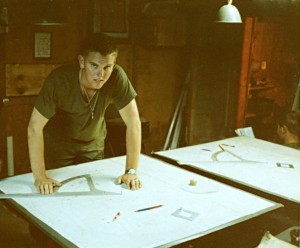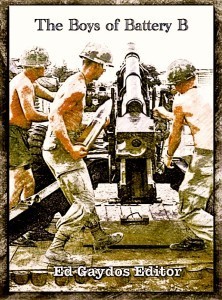John Clay – Gun Crew – Part One
I dropped out of college and volunteered for the draft for personal reasons. I just wanted to get the hell away for a while. I went down to the draft board in February of ’69, got in line and when I reached the desk said I wanted to volunteer for the draft. The guys behind me in line looked at me like I was nuts. So they drafted me on Fools Day April 1. Three months later they came out with the lottery and gave me a very high number, which meant I never would have had to go to Vietnam. Still I am so glad I went, and so glad I did my time.
In basic training at Ft. Ord, California they offered me a spot in Officer Candidate School. To do that I had to re-up for an extra year, so I said, No thank you. I went to Ft. Sill for artillery, took a bunch of tests and they offered me the E5 school. I said, No thank you to that too.
I was trained at Ft. Sill as a cannon cocker, but when I got to Sherry they were looking for people to help out in Fire Direction Control because they did not have enough trained people. The First Sergeant asked if anybody had been to college. I remembered never volunteer for anything, but I went ahead and mistakenly raised my hand anyway. At first I had a good time there. I handled the radios for a while, communicating with the guys in the field and back at Phan Thiet, and then they had me plotting fire missions. My training was all OJT.

John in Fire Direction Control at the plotting tables
Note the two tables. During a live fire mission there was always a guy on a second chart figuring up the same data as a check. Before the firing commands could go to the howitzers every setting had to be called out from the primary chart and answered with a “CHECK” from the guy on the second chart.
Pretty soon I was bored to death in FDC because that is not what I was trained for. I kept asking, “When can I go out to the guns?” We worked 12 on and 12 off, and the only time I got to meet the guys on the guns was at night. I’d walk around and talk to them. I actually volunteered for a mine sweep into Phan Thiet, just to get the hell off the battery.
Finally after four months someone came into FDC who was trained and I went out to Gun 5. I think the name of Gun 5 was BOOM BOOM. One of the guys on the crew had been wounded five months prior when Gun 3 took a direct mortar hit. His chest was just a mass of scars.
I started out as an ammo humper, then worked the radios, and ended up being the gunner after a couple months. (The gunner and assistant gunner operated the howitzer during a fire mission.) You’re running around checking the fuses and getting the right settings on the gun. And you had to be quick. I think that’s why I was the gunner most of the time because I was quick at setting the gun up. I’ve always been able to learn stuff pretty fast. Probably why I started off in FDC.
Gun 5 was the battery base piece (the gun on which the battery was registered and therefore the most accurate of all the guns). Before I got to Sherry Gun 3 in the middle of the battery was base piece, but after it got hit they reconfigured the battery into a circle so every gun had a clear view for perimeter fire. That’s when they made Gun 5 base piece, and the spot where Gun 3 was stayed empty and became sort of holy ground.
On base piece we shot tons and tons of fire missions, because if you ever just needed one gun it would be us. On the gun you were just always there. A typical day was clean the gun, fill sandbags, cut powder charges, take the extra powder bags out to the trash dump, and burn them.
Every 105 mm round came with seven bags of powder numbered 1 through 7 and strung together with a cotton cord – a kind of artilleryman’s rosary. Setting a specific charge involved cutting loose the desired number of bags and loading them into the canister. The extra bags piled up and had to be disposed of, usually by burning them at the trash dump outside the wire.
Then you had guard duty at night. We did not have shifts like in FDC. We were always on. I can’t tell you how many times you were asleep and heard that thump from a mortar tube and you were up and out of your hooch as quick as you could. If you were already on guard duty you got to the gun and pulled the lanyard. There was a high explosive round with a short time fuse you always kept in the gun. It would explode out above the wire in case anyone was out there. You only had a few seconds before the mortar landed to get back under cover. You had time between the thump and when the mortar landed, but you had to be quick. That was typical stuff you did on a regular basis.
I’ve got tinnitus, ringing in my ears, from my time on the guns. The earplugs they gave you were those crappy little rubber things compared to the ones they have now days. And it was kind of hard to wear them because the radio operator sat in that little sandbag bunker and yelled the commands to the gun that came from FDC. If you had your earplugs in you could not hear them that well. I was constantly pulling them out and putting them in. Half the time I’d just hold my hands over my ears, which the assistance gunner could not do because he was pulling the lanyard. There’s a big difference between a charge one and a charge seven.
Imagine an ice pick in each ear and a baseball bat to the chest, that’s what standing next to a charge seven without ear protection felt like. Now imagine that 30 times in quick succession, ten times a week for year, and you begin to approach the ordinary life of a howitzer gun crew.
I never got to the rear very much. We’d go on convoys to Phan Thiet and then come right back again. Some guys got headquarters jobs up in Phan Rang but I never wanted to. For some reason I just liked being where I was.




